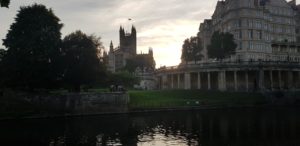For an international student, the UK is full of thrilling places to visit – one of these is Bath. Featured widely in literature and a tourist hot spot, Bath is widely known for being a wonderful, historic city. As a bonus – this lovely city, a UNESCO World Heritage site, is barely a two-hour train ride from Exeter St. Davids. (Or a slightly longer but cheaper coach ride.) I’ve wanted to visit Bath for ages, ever since I read Jane Austen’s novels. Seeing its charm and wandering around its cobblestone streets while seeing all the majestic sand colored architecture was a dream come true.

It’s a cute view outside the train station, with the river Avon cutting through the streets. I started my sightseeing tour there, taking a short walk along the river and taking in the nice sights. The next step was walking into the city centre and the heart of Bath, starting on the City trail to visit the greatest sights in Bath! I started off near the Bus station and walked past the Queen Square, considered a marvel of 18th century town planning, to reach the Jane Austen Centre. This is a little museum dedicated to Jane Austen, who lived at Bath for a few years. It includes a Regency tea room and the chance to dress up in historic clothes! Walking past this brought me to the King’s Circus and Assembly rooms. These Georgian buildings are known for their great architecture and symbolism. Charles Dickens used to read to the public in the Assembly rooms, being another great writer who left his mark on the city!
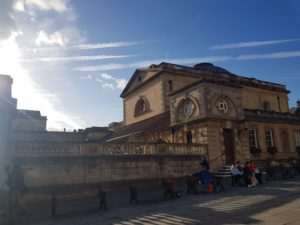
I then cut through town, going past the Guildhall to the main reason for Bath’s name and fame – the Roman Baths and the Bath Abbey right next to it. The Abbey itself is a glorious creation, standing proud with its lovely medieval turrets, gothic interior and stained glass windows. Apparently, the remains of the Romans baths, the ones built by the Romans in from 60 – 70 AD to the next 300 years, along with the Sacred Spring and the Temple of Sulis Minerva (the Roman goddess of war wisdom) are present under the Abbey’s yard. The baths are fed by natural heated springs, which attract everyone from the Celts to Romans to tourists from around the world today.

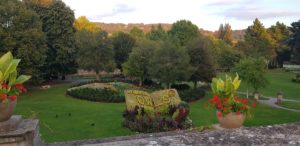
I sat at Indian Temptation, a completely vegetarian restaurant next to the Abbey, filling up on rotis and curry while gazing at the Abbey through lunch! Then, the route led me past the gorgeously laid out Parade Gardens cross to the North Parade Bridge and from there to the Pulteney Bridge. The great views of the rolling hills in the distance to the Sham castle (a facade built for an entrepreneur!) as well as glimpses of the Abbey are lovely from the Parade.
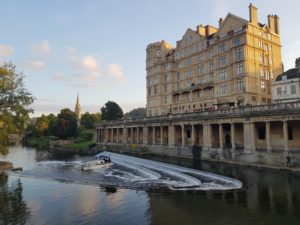
Walking along the Avon river to the Pulteney Bridge offered some lovely views, not to mention some great photos! I especially loved watching the swirling waters near the Bridge! It was definitely one of the cases where I saved the best for the last! I really didn’t want to tear my eyes away from the view of the city of Bath across the river in the blaze of the setting sun but reality called. It was then off to the Great Pulteney Street for a stroll amid the grand buildings and a glimpse of the Holburne Museum of Art before heading back to the station for my journey home.
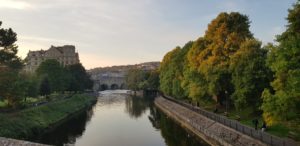
Bath is a city steeped in history, be it Roman, medieval or Georgian. Impossible to walk along there and not stumble into an old and meaningful monument! The Abbey itself is quite the centre-piece, towering majestically and giving a different feeling to the city view. The most eye-catching thing is definitely the fact that most buildings, including the abbey, are made of the locally sourced sand colored Bath stone, giving it a very quaint feel.
Bath is definitely something to put on your bucket list of places of visit whilst you’re studying at Exeter. If you enjoy history, beautiful vistas and exploring the feel of England through the ages, then Bath is the place to go!
